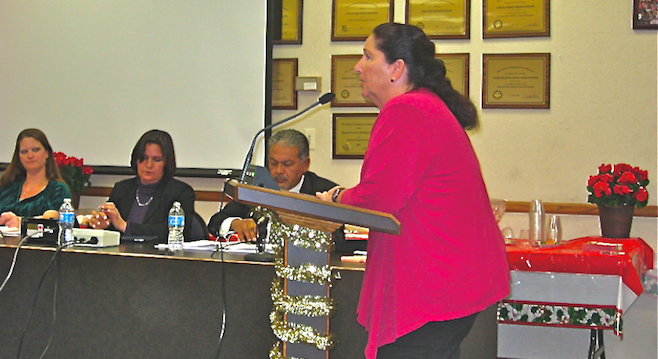 Facebook
Facebook
 X
X
 Instagram
Instagram
 TikTok
TikTok
 Youtube
Youtube

The imminent strike action of teachers, librarians, and nurses in the Sweetwater Union High School district has gone one step forward and two steps back.
On March 27 Superintendent Ed Brand called a press conference and explained the district’s recent contract proposals. According to several media, the proposals bring the two sides closer.
However, on the same day as the press conference Sweetwater Education Association president, Roberto Rodriquez, responded to the proposal with an angry letter which reads in part:
“…by disclosing details of the proposals exchanged during the mediation process (which are not binding) to our members and the media, Ed Brand also violated the confidentiality that both sides agreed to when we entered mediation.”
On March 27 the district was also denied a petition for injunctive relief against “unlawful strike activity.”
The background to the petition is that on March 14 the majority of teachers voted to authorize their association board to call a strike when necessary. The district responded to the vote the same day, according to a letter by superintendent Brand, by putting together 127 pages of “voluminous factual evidence” which sought a court order to stop “unlawful strike activity.”
The Public Employee Relations Board, the state agency called in to assist in negotiations, responded with one sentence — denying the district’s petition for “sufficient grounds not having been demonstrated.”
There was yet another setback in negotiations when the mediator for the Public Employee Relations Board moved the negotiating process from impasse to the final step — Fact Finding.
During fact finding, a three-person panel reviews material for both sides and proposes an agreement. After fact finding, which lasts approximately two months, the district can impose a final agreement. At this point teachers can legally to decide to strike or not.
The district’s latest offer, as presented on March 27, includes a 2% wage increase for 2013-2014 and a 3% increase for 2014-2015 — but the sticking points continue to be health benefits and class size.
Regarding class size, the district has proposed a class ratio of 30 students to one teacher.
In a March 29 interview Colleen Cooke-Salas, a 25-year teacher and Sweetwater Education Association vice-president said:
“While that looks good on paper, you have to remember that librarians, nurses, speech therapists and specialized classes are factored into that equation, which makes the average class size much higher.
“With a 30:1 ratio the teachers can still have up to 180 student contacts a day. Some classes might be very large. Physical Education classes, for example, are so large they pose safety issues. While we were negotiating recently we had a student injured in a P.E. class — there were just too many students in that class.”
Negotiations can continue during fact finding and the association has promised to notify parents and bargaining unit members 24 hours before a strike.


The imminent strike action of teachers, librarians, and nurses in the Sweetwater Union High School district has gone one step forward and two steps back.
On March 27 Superintendent Ed Brand called a press conference and explained the district’s recent contract proposals. According to several media, the proposals bring the two sides closer.
However, on the same day as the press conference Sweetwater Education Association president, Roberto Rodriquez, responded to the proposal with an angry letter which reads in part:
“…by disclosing details of the proposals exchanged during the mediation process (which are not binding) to our members and the media, Ed Brand also violated the confidentiality that both sides agreed to when we entered mediation.”
On March 27 the district was also denied a petition for injunctive relief against “unlawful strike activity.”
The background to the petition is that on March 14 the majority of teachers voted to authorize their association board to call a strike when necessary. The district responded to the vote the same day, according to a letter by superintendent Brand, by putting together 127 pages of “voluminous factual evidence” which sought a court order to stop “unlawful strike activity.”
The Public Employee Relations Board, the state agency called in to assist in negotiations, responded with one sentence — denying the district’s petition for “sufficient grounds not having been demonstrated.”
There was yet another setback in negotiations when the mediator for the Public Employee Relations Board moved the negotiating process from impasse to the final step — Fact Finding.
During fact finding, a three-person panel reviews material for both sides and proposes an agreement. After fact finding, which lasts approximately two months, the district can impose a final agreement. At this point teachers can legally to decide to strike or not.
The district’s latest offer, as presented on March 27, includes a 2% wage increase for 2013-2014 and a 3% increase for 2014-2015 — but the sticking points continue to be health benefits and class size.
Regarding class size, the district has proposed a class ratio of 30 students to one teacher.
In a March 29 interview Colleen Cooke-Salas, a 25-year teacher and Sweetwater Education Association vice-president said:
“While that looks good on paper, you have to remember that librarians, nurses, speech therapists and specialized classes are factored into that equation, which makes the average class size much higher.
“With a 30:1 ratio the teachers can still have up to 180 student contacts a day. Some classes might be very large. Physical Education classes, for example, are so large they pose safety issues. While we were negotiating recently we had a student injured in a P.E. class — there were just too many students in that class.”
Negotiations can continue during fact finding and the association has promised to notify parents and bargaining unit members 24 hours before a strike.
Comments